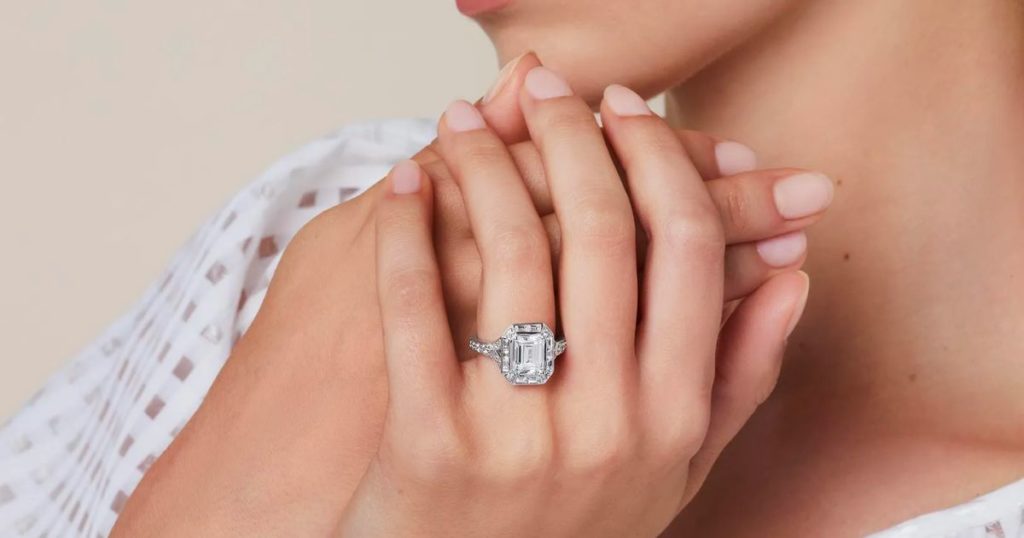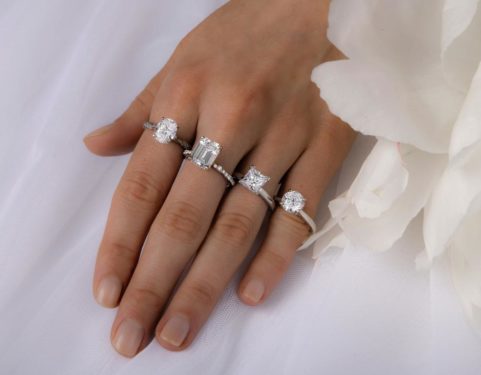Moissanite engagement rings have been popping up all over the jewelry industry these days and it’s not hard to see why. There are many benefits to buying a moissanite engagement ring over a traditional diamond engagement ring. Price, carat weight, and ethics are some of the most popular reasons why one might choose a moissanite engagement ring instead of a diamond engagement ring. Still, there are some things you should keep in mind before making your final choice. Here are some things you might not know about buying moissanite vs diamond engagement rings.
1. Is a Moissanite Engagement Ring Sparkly or Distracting?

Currently, moissanite stones are the most popular colorless diamond simulant around. The stone is especially brilliant, surpassing the subtle sparkle of a diamond. Moissanite’s flashy brilliance is often praised for its fire, earning the the popular comparison to a disco ball effect.
But if you’re someone who likes subtle or minimalist engagement rings, moissanite stones might not be your calling. If you’re particularly sensory, you might find the brilliance a tad overwhelming.
Moissanite has a high refractive index. The refractive index in a gemstone is the ratio of the speed of light through one space to the speed of light through another. In a gem’s case, it would be speed of light through the air compared to its speed through the stone.
Gemstones with a higher refractive index produce a flashy brilliance. Both moissanite and another popular diamond simulant called cubic zirconia have a higher refractive index than a diamond.
The brilliance of these stones is almost a surefire way to detect a fake diamond. Cubic zirconia has a brilliance similar to moissanite, both displaying strong rainbow light. A diamond produces an equal balance of both white light and rainbow flashes.
Moissanite gems are also double refractive, meaning that the light entering a gemstone can enter the stone and split into two rays of light back out of the stone. Many say this sparkly effect can cause doubly refractive gems to appear blurry.
Diamonds aren’t double refractive. If a moissanite is cut well, the double refraction effect will not be seen in your moissanite ring. That leads us to another issue with choosing a moissanite stone.
2. Confusing Quality Factors for Moissanite Stones
Diamond jewelry and engagement rings have strict guidelines when it comes to quality and diamond grades. Moissanite, on the other hand, does not.
The first thing you need to know is that anything labeled “real moissanite” is a lab created gemstone. Naturally occurring moissanite is extremely rare and isn’t available commercially. Natural moissanite earned itself the names “Space Diamond” and “Stardust” after being found inside a crater by a French scientist named Henri Moissan.
Moissanite stones have the same features as natural moissanite, just like lab created diamonds have the same features as natural diamonds. But unlike lab created diamonds and mined diamonds, there’s no jewelry standard for a moissanite engagement ring. A diamond ring has a clarity grade and color grade, but moissanites don’t.
3. A “Kinda” Colorless Diamond Simulant

Diamond color grades found at retailers are usually found can be colorless, near colorless, or faint yellow.
Not every moissanite retailer separates qualities of moissanite. And while many moissanite retailers advertise moissanite stones as colorless diamond alternatives, not every moissanite stone will be colorless all the time.
Let me explain.
You can find stories all over the web of people asking various message boards about why their moissanite rings look gray or dark in different lighting despite purchasing a high quality moissanite.
That’s just how the moissanite looks sometimes. Even the highest quality of premium moissanites made can look this way.
Other colorless gemstones like white sapphire don’t appear as colorless as a diamond, either. At first glance, it’s colorless. But in different lighting, it casts a silvery light instead of white and rainbow light.
4. Durable as a Diamond?

One of the biggest comparisons of moissanite vs diamond is the overall wearability of the stone. Moissanite has excellent wearability, just like a diamond. But there are some differences in their wearability as well.
For example, you might know that natural diamonds and lab created diamonds are the hardest known mineral on the earth. But the “hardness” is the gem’s ability to stand up to the dust and dirt particles in the air from everyday wear. You know, like wearing an engagement ring for years and years.
Every mineral on earth has a rating on the mineral scale of hardness, known as the Mohs scale. Diamonds hit a 10 on the Mohs scale, which is the highest rating given. A moissanite stone rates a 9.5.
So, it’s easy to assume the scratch resistance of moissanite rings is basically the same as a diamond.
Not quite.
Sapphires hit a 9 on the Mohs scale. According to gemologists, a diamond is 4x harder than a sapphire despite being only one rating away. The Mohs scale isn’t your typical numerical scale.
A moissanite ring is capable of scratching over time. It’s unlikely that it’ll affect the look of your moissanite for years, but it’s still not quite as scratch resistant as a diamond.
Of course, I have to play devil’s advocate here, because it’s the opposite when it comes to chipping or breaking if dropped. Moissanite is less susceptible to chipping if dropped. Diamonds are more susceptible because of the way their crystal structure is.
But if you really get down to it, both moissanite and diamond have the overall durability that will make them hold up for years to come as long as you take care of them. Neither one of them are impervious to damage, no matter where you buy them from.
5. Ethical Alternatives to Natural Diamond Engagement Rings

Moissanite makes a great alternative to buying a natural diamond if you’re concerned about ethics. Mined diamonds require more workforce, whereas moissanite jewelry is created in a lab environment. There’s no high value in moissanite, so there’s no threat of it being used to control surrounding communities.
You don’t have to come down to a battle of moissanite vs diamond when it comes to ethics. Lab created diamonds are as ethical as moissanite. Lab created diamonds have all the same durability and brilliance attributes as mined diamonds. They allow you to still have the subtle brilliance and fire of a diamond.
By choosing a lab created diamond, you get all the same benefits as a natural diamond as well as the same safe ethical background that moissanite would give a customer.
Moissanite vs Diamond: Final Thoughts

Both moissanite and diamond can make beautiful and durable engagement rings that last for years and years if given the proper care. Moissanite comes at a much lower price per carat than mined or lab diamonds.
While some may regard moissanite’s brilliance as artificial, others revel in the balanced reflection of a diamond. This, of course, is personal preference.
It can be very difficult to pick out a high quality moissanite with no standard grading system for them. They aren’t certified by any reliable grading labs, unlike diamonds (mined or created).
At the end of the day, we all have our reasons why we might choose one gemstone over another for our engagement ring. We all have different tastes, lifestyles, and budgets. But you should always know all the facts before making a final decision.
And for those of you looking for a happy medium between moissanite vs diamond, I definitely recommend checking out our lab created diamonds as a more affordable and ethical alternative to mined diamonds.



